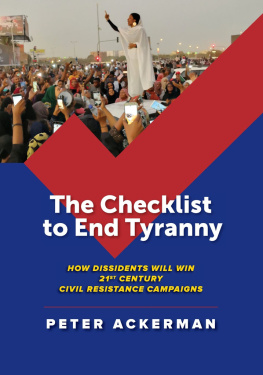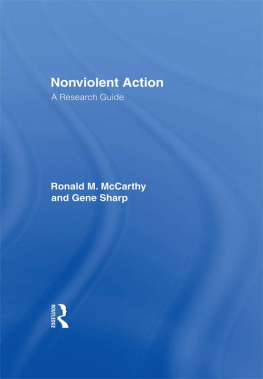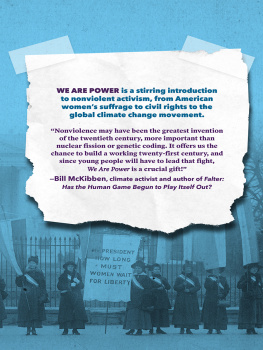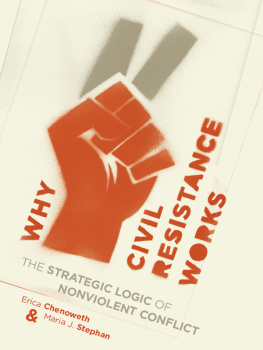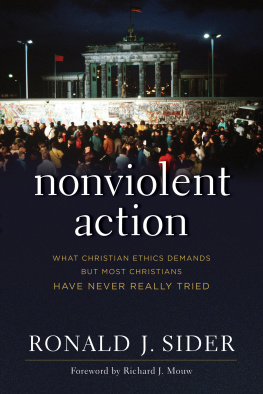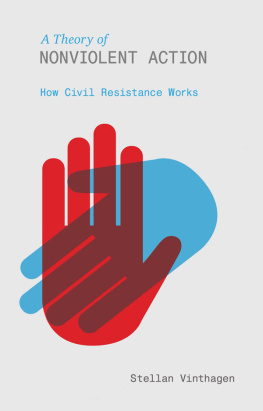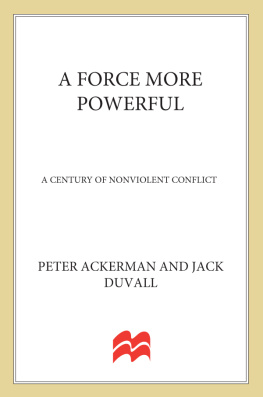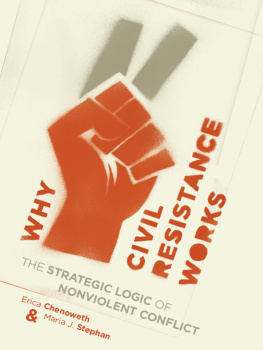A FORCE MORE POWERFUL
A CENTURY OF
NONVIOLENT CONFLICT
Peter Ackerman and Jack DuVall

Thank you for buying this
St. Martins Press ebook.
To receive special offers, bonus content,
and info on new releases and other great reads,
sign up for our newsletters.

Or visit us online at
us.macmillan.com/newslettersignup
For email updates on Peter Ackerman, click here.
For email updates on Jack DuVall, click here.
The author and publisher have provided this e-book to you for your personal use only. You may not make this e-book publicly available in any way. Copyright infringement is against the law. If you believe the copy of this e-book you are reading infringes on the authors copyright, please notify the publisher at: http://us.macmillanusa.com/piracy.
To Nate Ackerman and Elliot Ackerman
who will help shape the future
and
In memory of Margaret Clark DuVall (19111999)
who had faith in us all
The great English man of letters V. S. Pritchett, in writing about Leo Tolstoy, said that his novels illustrated the crucial Russian difficulty there seems to be no such person as a Russian alone. Each one appears in a crowd of relations and friends, an extravagantly miscellaneous and declaiming tribal court. That too has been our experience, in preparing, writing, revising, and editing this bookbut for us it was no difficulty; it was a privilege and a pleasure. We stand on the shoulders of our colleagues, both those who produced the documentary television series that was the occasion for this book and those whom we asked to participate in the research and preparation of its chapters and other content. Without their contributions to this project, ours would not have been adequate to the task.
Steve York produced and wrote the documentary television series A Force More Powerful, as well as the feature-length documentary film of the same name that was released in 1999. His incisive interviews of many participants and eyewitnesses who played a role in eight of the conflicts featured in the book made him our most-cited source. Without his assistance, this book could not have made a new contribution to the historical literature. Steves mastery of the subject matter of nonviolent conflict has been much deeper and more far-ranging than any other documentary filmmaker could have brought to this work, and we learned much from the rhythm and structure that he found and amplified in the stories featured in the series.
Jonathan Mogul was our senior research and editorial associate. With a doctorate in history from the University of Michigan and much fine scholarly work to his credit, he gathered the empirical material and furnished first draft narratives for what became the chapters or chapter sections on the conflicts in Russia, India, Poland, the American South, South Africa, Eastern Europe, and Sri Lanka. He also redeveloped material on the El Salvador story, performed supplemental research on the Chile and Philippines stories, and assisted with the conclusion. His conceptual judgment about the structure of our stories lent clarity to several chapters, and his keen sense of what would stand up to historiographical scrutiny helped discipline our speculative instincts.
Jeff Heynen, a graduate student at Georgetown Universitys School of Foreign Service and fluent in both German and Dutch, was our editorial associate on the Ruhrkampf and World War II resistance conflicts, providing first draft narratives for those stories. His responsive and unflagging research helped harvest the ripest material from many diverse sources. Jeff was also our intrepid aide in verifying and correcting end notes and creating the index.
Carl Posey was our editorial associate on the Argentina and Chile conflicts, doing first draft narratives for those stories. He also assisted us in reshaping and revising the chapters and chapter sections on the conflicts in Russia, India, Poland, South Africa, China, Eastern Europe, and Mongolia. He often helped levitate the merely factual to the level of what offers a sense of human texture and color.
Greg Michaelidis was our editorial associate on the intifada and the conflicts in the Basque country, Burma, and Serbia, providing first draft narratives for those stories. His interviews of subjects and diligent pursuit of elusive information were invaluable. Michael Connelly was our editorial associate on the people power revolution in the Philippines and provided a first draft narrative for that story, helping us to identify the right moments to highlight in that densely paced conflict.
To prepare the China and Mongolia stories, we were fortunate to have the help of Morris Rossabi, one of the nations foremost academic authorities on the Far East. He provided first draft narratives on those two conflicts, and his rich familiarity with the events and people in Ulaanbaatar was crucial in making the Mongolia account a fresh addition to the growing literature on nonviolent conflict.
We are also greatly obliged to Miriam Zimmerman, who completed our photographic research and compilation and was a partner in all phases of this project. Felicia Widmann, our photographic coordinator, was indefatigable in identifying and bringing back a towering collection of images. Jan Camps contributions to the early effort in gathering this material were also most appreciated, as was the help of Heather Rush and Matthew Richardson. Alex Tait of Equatorial Graphics rendered our clear and informative maps.
Our gratitude also goes to Rosemary Umaru, Rosalyn Abraham, Valerie Cunningham, and Bridget Durand for their patience and hard work in coordinating the communications between the two of us; to Channing Walker for his timely support; to Sandy Goroff, our publicist, and to Susan Rumberg at WETA for her assistance in facilitating our contacts with PBS.
Particular thanks are due Bruce Jenkins of the Albert Einstein Institution, Sidney Tarrow of Cornell University, and Doug McAdam of Stanford University for their thoughts and reflections about the subject of the book and the series in informal conversations. They pointed out useful ideas in a way more valuable to us than it may have been apparent to them at the time. We are also thankful for the interviews conducted by Tom Weidlinger for several stories featured in the series and represented by excerpts in the book.
Of special help was Joanne Leedom-Ackerman, whose vision and perspective, bred of long involvement in the field of nonviolent conflict, gave us confidence to know that this books distinctive purpose could be fulfilled. Also, no work even remotely related to this subject should lack an acknowledgment of the intellectual leadership of Gene Sharp, who has done more to advance the ideas at the root of modern nonviolent action than any living person.
Finally, we are very grateful to our editor at St. Martins Press, Karen Wolny. Her enthusiasm for the books concept and her shrewd advice about how to focus and abridge the longer stories made her the ideal shepherd in helping us find the way to a full expression of the vision that has motivated the book from the outset. Alan Bradshaw and Jennifer Simington were indispensable (and amazingly serene) in the copy editing process.
The documentary television series A Force More Powerful was made possible by the enlightened support of Susan and Perry Lerner, the Albert Einstein Institution, Elizabeth and John H. van Merkensteijn, III, Abby and Alan Levy, and the Arthur Vining Davis Foundations. Initial series research was funded by the U.S. Institute of Peace. Without the generosity of each of these individuals and organizations, neither the series nor the book would now be available to millions in North America and throughout the world.
Next page

